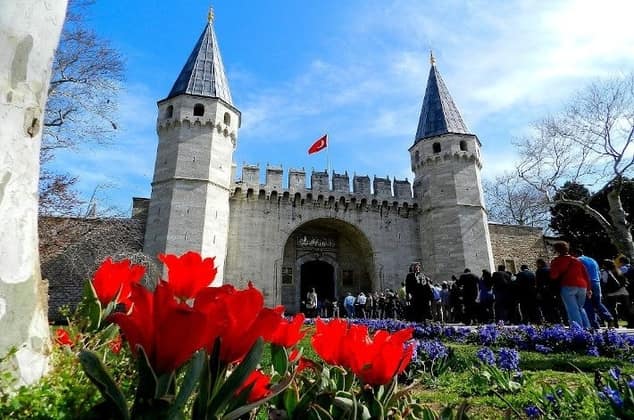
Tips for Topkapi Palace Visitors:
Transportation to Topkapi Palace:
The palace is located in the Sultanahmet area, which is the historical city center of Istanbul, and it is easily accessible via public transportation.
From the Old City : Take the T1 tram to Sultanahmet tram station. From there, it’s just a 5-minute walk to the palace.
From the Taksim : Take the funicular from Taksim Square to Kabatas. From Kabatas, take the T1 tram to Sultanahmet station. Then, walk for 5 minutes to reach the palace.
From the Sultanahmet:Most hotels in the area are within walking distance of the palace.
Visiting Hours: 09:00 to 18:00 (except tuesday)
Entrance Fee:750 TL + 350 TL extra for Harem
Avarege Visit Duration: 2-3 hours (guided)
Best hours to visit: 9-10 am
About Topkapi Museum in Istanbul Turkey
[acf field=”{$entrance_fee}”]
Table of Contents
The Topkapi Palace, which is the oldest and largest palace that has survived to this day, served as the administrative and domicile centre of the Ottoman Empire for almost 400 years. The palace was built between 1458 and 1478 by the Conqueror Sultan Mehmet. Subsequent Sultans who ruled after him made other extensions to the palace until the 19th century.
During the reign of Sultan Abdul Majeed, the Topkapi Palace lost its primary importance as it was deemed inadequate for the needs of the state protocols of the 19th century. As a result, the palace was moved to Dolmabahçe, a palace built on the Bosphorus in 1854. However, the holy relics, treasures, and archives of the Empire were still protected at Topkapi Palace, and certain traditional ceremonies and celebrations continued to take place there following the abolishment of the Ottoman Sultanate.
In 1922, Topkapi Palace was converted into a museum by the order of Mustafa Kemal Atatürk. On the 3rd of April 1924, the museum opened to the public and offers guidance services every day except Tuesdays.
Topkapi Palace Video
Fatih Sultan Mehmet and Topkapi Palace
After the conquest, Mehmed the Conqueror built a palace in Beyazıt, where Istanbul University is now located, which was later known as the Old Palace. After this first palace, Fatih built the Tiled Pavilion and then the Topkapı Palace, where he settled when it was completed. Fatih named this palace “Saray-ı Cedid”, which means “New Palace” in Ottoman Turkish. The new palace was later called Topkapi Palace: When the large wooden coastal palace built by Sultan Mahmud I near the Byzantine walls was completely destroyed by fire. It was called “Topkapus Coastal Palace” because of the saluting cannons in front of The old wooden Palace. (Canon:top and door:kapi so topkapi means “door with canons)
Architecture of Topkapi Palace
The philosophy of the Ottoman state and the relationship between the palace and its subjects played an important role in determining the plan of Topkapi Palace, which developed and grew over the centuries. It is also known that when Topkapı was first built, it was inspired not only by the plan but also by the splendour of the Edirne Palace built by Sultan Murad II, the father of Mehmed the Conqueror, on the banks of the Tunca River, of which only the ruins remain.
Topkapı Palace is a modest palace; the great expenditures of the empire were mostly on magnificent mosques, barracks, bridges, caravanserais and accommodation. Even the famous 16th century architect Mimar Sinan only built part of the palace. But the palace’s unique buildings, exquisite tiles and its structure intertwined with nature, as well as its location on Sarayburnu, give it a natural beauty and splendour.
Sections of Topkapi Palace
The plan of Topkapi Palace consists of various courtyards and gardens, apartments for state affairs, buildings and villas for the sovereign’s residence and buildings for the officials living in the palace. Built on the Byzantine acropolis of Sarayburnu, at the tip of the Istanbul peninsula between the Sea of Marmara, the Bosporus and the Golden Horn, the Palace was surrounded by the Byzantine walls on the land side and the Byzantine walls on the sea side with high walls called “Sur-ı Sultani”, 1400 metres long. The area of the palace is about 700 thousand square metres.
Procession Square, Hagia Irene, Bâb-ü’s Selâm, Bâb-ı Hümâyun, Divan Square, Kubbealtı (Divan-ı Hümayun), Law Pavilion, Outer Treasury, Zülüflü Baltacılar Ocağı, Stables, Beşir Ağa Mosque and Bath, Palace Kitchens, Babüssaade, Sohum Castle Inscription, Enderun Yard, Arz Room, III. Ahmed Library (Enderun Library), Fatih Pavilion (Enderun Treasury), Treasury Ward, Has Room and Holy Relics Department, Agalar Mosque, Kilerli Ward, Kuşhane and Harem Gate, Has Room Ward / Sultan’s Portraits, Fourth Courtyard, Circumcision Room, Revan Pavilion, Baghdad Pavilion, Iftariye Kameriyesi (Moonlight), Sofa Pavilion, Sofa Mosque, Mecidiye Pavilion, Hekimbaşı Room / Head Lala Tower, Esvap Room, Harem, Cabinet Dome / Harem Treasury / Haremeyn Treasury, Sofa with Fountain, Kara Ağalar Masjid, Kara Ağalar and Kara Ağalar Taşlığı, Sentence Gate, Valide Taşlığı, Women Efendi Apartments, Valide Sultan Apartment, Hünkâr and Valide Sultan Baths, Hünkâr Sofası, III. Murad’s Room, Ahmed I’s Room, Yemiş’s Room / Ahmed III’s Room, Double Pavilions / Veliahd Apartment, Golden Way, Concubines and Female Lords’ Tachyons, Gözdeler Apartment and Mabeyn Tachyons, Carriage Gate / Girls’ Gate, Watchtower and Concubines’ Corridor are some of the sections of this huge structure.
Topkapi Palace Photos
Topkapi Palace Museum Collections
Topkapı Palace is one of the most spectacular palaces in the world because of its extraordinarily rich collections and its history, which is interwoven with extremely interesting stories. The Imperial Treasury, European Porcelains and Glasses, Copper and Tombak Kitchenware, Chinese and Japanese Porcelains, Silver, Chamber of Cardigans and Holy Relics, Istanbul Glass and Porcelains, Sultan’s Clothes, Sultan’s Portraits and Paintings Collection, Weapons are among the valuable collections exhibited in the museum.
Source: Topkapi Palace Museum website